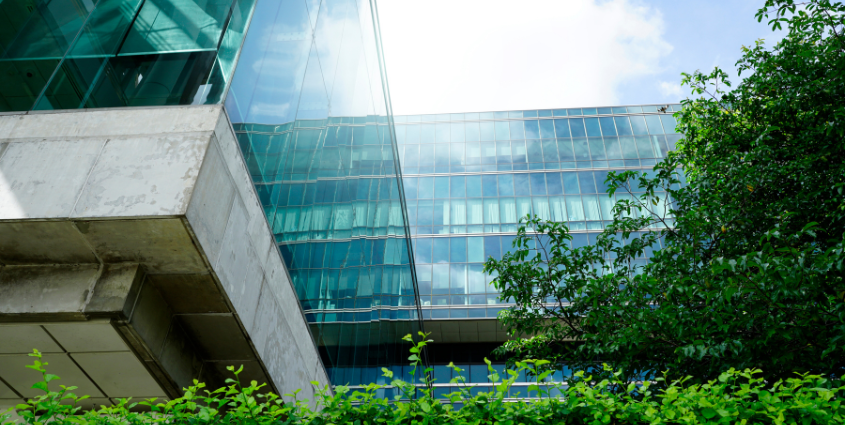How onsite water reuse can help lower carbon emissions in buildings


According to The Climate Group, buildings account for 40% of global greenhouse gas (GHG) emissions today. By 2050, the built environment could be responsible for 80% of GHG emissions if we don’t change course. Energy efficiency is a main driver in creating cleaner building outputs, but did you know that water reuse can also help lower building carbon emissions?
Consider this: California Department of Water Resources estimates that 12% of the state’s total energy use goes toward pumping, treating, and heating water, and may account for up to 10% of its GHG emissions. By reducing the energy required to treat and transport wastewater, onsite water reuse can play a vital role in reaching your project’s sustainability goals.
Ways water reuse can help with building decarbonization
Water reuse in buildings offers a holistic approach to sustainability by aiding both water and energy conservation goals. Real estate owners can take control of their water supply by designing innovative buildings that maximize efficiency and resiliency while reducing their environmental impact on communities. Here are a few ways water reuse can help reduce carbon emissions in buildings:
Energy savings
As we know, the conventional approach to wastewater management requires a considerable amount of energy, both in transportation through our vast network of underground sewer pipes and in treatment from traditional wastewater processing plants. As more and more buildings look to reduce their Scope 3 emissions, the embedded energy of municipal water becomes an important metric, especially in locations such as Southern California where water is pumped in from hundreds of miles away or through an energy-intensive desalination plant. While the embedded energy of municipal water varies by city, in many instances either due to physical constraints (such as distance) or infrastructure constraints (undersized mains, old systems), the energy use from an onsite reuse system produces less emissions than the centralized approach.
In addition to reducing embedded energy, onsite reuse systems can also be more efficient because they are sized for a smaller range in flows than municipal systems, allowing the equipment to operate within optimal performance ranges. Lastly, using recycled water for non-potable uses can be an energy saver in itself, as treating wastewater for non-potable reuse locally instead of the energy-consuming purification treatment needed for drinking water standards results in energy savings and lower associated carbon emissions for the building.
Integration with sustainable design
Incorporating water reuse into the initial design phase of buildings allows for the integration of efficient water systems and can be part of a broader sustainable building design strategy. Green building practices, which often include water-efficient technologies, consider both water and energy efficiency, leading to overall lower carbon emissions throughout the lifecycle of the building. Epic’s technology helps buildings reuse up to 95% of their wastewater, and implementing our full suite of resource recovery solutions (water, soil, and heat energy) can earn up to 24 LEED points.
Our wastewater heat recovery system is geared toward reducing the load on plumbing and HVAC systems, which typically amount to 50% of building energy use. By using passive heat exchange to recover the heat energy in building wastewater and transfer it to domestic hot water or hydronic water, the heating demand on the building’s heat pumps and chillers may be significantly reduced, and the associated energy use from that equipment goes down. Wastewater collection tanks act as thermal storage tanks when heat recovery is utilized.
Our soil amendment products are a natural alternative to fossil fuel-intensive chemical fertilizers and yield heartier plants and more robust root structures that sequester even more carbon in the ground. By upcycling wastewater organics, buildings can divert them from landfills where they often emit harmful greenhouse gases like CO2 and methane into the atmosphere.
Demand impact
Water reuse reduces a building’s demand for potable water, especially in regions facing water scarcity. Extracting, treating, and distributing freshwater involves energy-intensive processes. With onsite reuse from greywater, blackwater, rainwater or stormwater sources, there is a reduction in need of freshwater resources, leading to lower carbon emissions. Buildings that implement reuse systems may also benefit from tenant and resident behavioral changes. When you implement water reuse and market it as a benefit to building occupants, you raise awareness about water conservation and sustainable practices. This can lead to actionable changes that extend beyond water reuse, contributing to a more sustainable lifestyle and reduced overall environmental impact.
Reuse SCADA systems also come enabled with tracking capabilities, so you know exactly how much water is coming into and leaving the building. This includes identifying when any leaks occur, sending notification so operators can address issues quickly thus saving water and reducing GHG emissions. Epic’s OneWaterTM system includes a built-in ESG dashboard that details real-time water and energy savings as well as carbon avoidance, empowering building operators to easily align their operations with sustainability goals. Along with the ESG dashboard, the system is also equipped with a comprehensive cloud-enabled controls capability that allows Epic operators and building maintenance teams to monitor and operate each system remotely, thus minimizing on-site operator time and reducing ongoing operational costs.
Commit to the Wastewater Zero initiative
Globally, 80% of our wastewater is discharged directly into the environment without proper treatment. As we look for new ways to innovate while minimizing the impact our buildings have on the environment, the Wastewater Zero initiative is another mechanism businesses can use as a guiding light. Developed by the World Business Council for Sustainable Development (WBCSD) this initiative encourages businesses to reduce the impact of their wastewater on the climate, biodiversity, and water security. They outline three main goals of their initiative:
- Zero pollution: treat wastewater so it has no negative impact on the receiving body of water.
- Zero freshwater impact: design systems to increase onsite reuse and recycle water to replace freshwater withdrawals in water-scarce areas.
- Low-carbon treatment: adopt wastewater treatment processes that reduce GHG emissions and net energy requirements where feasible.
Recognizing sustainable wastewater treatment solutions as a key element to helping fight climate change and aiding in building decarbonization is a responsible step toward a more resilient future.

